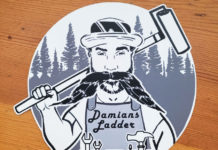When I think of autumn, I think of how the gold leaves of the sycamores and the big leaf maples illumine the forest and the river. And when I think of the river, I think of what Fred McPherson, local naturalist and videographer, has always said; “The river is my teacher.”
“What it says to me is where I’m coming from. It always gives me a chance to attune with my inner self. The river calms me down and then I hear the inspiration that is there all the time, but we are so busy, we don’t listen to it.”
Sometimes, Fred will take a question to the river; it might be about a bird or a rock. He can get a sense of geological time — like how the granite, which suddenly shoves itself up from the river’s sandstone, ended up here.
He chronicles his observations, then organizes them so they start to tell a bigger story, “like about a whole species or a phenomenon in nature.”
Every time Fred goes out into nature, he discovers something.
“It’s where you can have a serendipitous experience,” he says.
If you would like to go exploring, join Fred and I for our last watershed walk of the year on Saturday, Oct. 18, at Henry Cowell Redwoods State Park.
First, we will explore the riparian corridor, perfumed with the bay tree’s menthol-smelling leaves, which served as a pharmacy for California Indians. Leaves were used to treat headaches by placing one in a nostril or made into tea to cure stomachaches, colds, sore throats, and phlegm.
The nuts, which are falling now, have many culinary properties. For instance, they were roasted — creating a coffee-like flavor — and eaten shelled or pounded into meal for cakes.
Our citizen scientists will investigate some of the signs of drought, like how dry creek beds are filling up with baby alders, blackberries, and non-native and invasive French Broom.
We will follow Fred as he leads us down the rabbit hole and into the hidden life of the San Lorenzo River during low-flow Indian summer.
“I want to get people down in the river channel, as well as the upper flood plain,” he said. “We will take a look into the river water, at its surface and bottom, and explore the pools, riffles, and back waters of the stream bed to see how the plants and animals are adapting.”
On a recent scouting expedition for our walk, Fred explored the riverbed where he saw little trails going off, so he started following one and was drawn into the underbrush. Then, he started to see where the water had washed out one area, and animals had begun traveling through.
The pathfinder followed more hidden byways. “I was guided that way to see so many things. I saw pools with duckweed on them that I don’t think anybody else had seen.” Duckweeds, the smallest flowering plants, float on still or slow-moving fresh water throughout the natural world.
Fred saw little frogs and crawdads. He became aware of birdsong, because when you are at that heightened state of awareness, birds calls become more than just elevator music to the background of your life.
“I was led into a bigger trail and then more water,” he said. “I didn’t know where I was going but I was guided into a bigger story. I followed my bliss, my intuition.”
Along the river’s edge we will study igneous and sedimentary rocks. What are their origins? Many new trees have fallen. Is that due to the drought? Fred and I encourage our explorers to document what they experience with photos, sketches, and nature journals.
This free, two-hour walk is sponsored by an environmental education grant from the San Lorenzo Valley Water District. If you want more information on the walk, please contact me at ca****@*********on.com.
– Carol Carson is a nature writer and Certified California State Master Naturalist.













